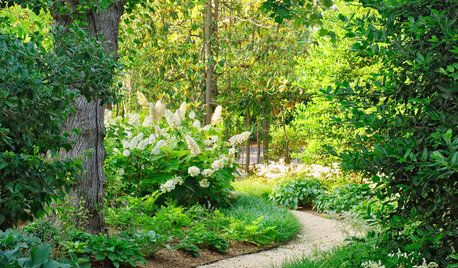Use your own yard debris for mulch.
Gary Sutcliff (Ledyard CT Z6)
9 years ago
Related Stories

GARDENING GUIDESNew Ways to Think About All That Mulch in the Garden
Before you go making a mountain out of a mulch hill, learn the facts about what your plants and soil really want
Full Story
GARDENING GUIDESHow to Pick a Mulch — and Why Your Soil Wants It
There's more to topdressing than shredded wood. Learn about mulch types, costs and design considerations here
Full Story
GARDENING GUIDESThe Art of Green Mulch
You can design a natural garden that doesn’t rely on covering your soil with wood and bark mulch
Full Story
EDIBLE GARDENSHow to Grow Your Own Peaches and Nectarines
Make gardening a little sweeter with these juicy fruits, which you can eat after plucking or preserve for later
Full Story
FARM YOUR YARD6 Things to Know Before You Start Growing Your Own Food
It takes time and practice, but growing edibles in the suburbs or city is possible with smart prep and patience
Full Story
EDIBLE GARDENSHow to Grow Your Own Sweet Summer Crops
This guide will help any gardener get started on growing the freshest warm-season veggies and berries for summer
Full Story
GARDENING GUIDESGrow Your Own Privacy: How to Screen With Plants and Trees
Use living walls to lower your home and garden's exposure while boosting natural beauty in your landscape
Full Story
FRUIT TREESHow to Grow Your Own Persimmons
Sturdy and easy to care for, these trees offer bright fruit through winter — and keeping them in bounds is no sweat
Full Story
FALL GARDENINGBe Your Own Wildflower Nursery
Gather seeds from your garden in fall, and you'll have a selection of plants for next year — without spending a dime
Full Story
LANDSCAPE DESIGNUnwind in Your Own Private Garden Escape
When the world is getting on your last nerve, an outdoor refuge can soothe and nurture. Here's how to design a garden with relaxing in mind
Full Story






toxcrusadr
toxcrusadr
Related Professionals
New Bedford Landscape Architects & Landscape Designers · Otsego Landscape Architects & Landscape Designers · Prairie Ridge Landscape Architects & Landscape Designers · Rancho Cordova Landscape Architects & Landscape Designers · Bellefontaine Neighbors Landscape Contractors · Maywood Landscape Contractors · North Ridgeville Landscape Contractors · Pleasanton Landscape Contractors · Welby Landscape Contractors · West Haverstraw Landscape Contractors · Eastlake Landscape Contractors · Des Moines Decks, Patios & Outdoor Enclosures · Fishers Decks, Patios & Outdoor Enclosures · Redlands Decks, Patios & Outdoor Enclosures · Rosemont Decks, Patios & Outdoor Enclosuresemerogork
Kimmsr
toxcrusadr
nil13
emerogork
Kimmsr
toxcrusadr
emerogork
Kimmsr
david52 Zone 6
nil13
toxcrusadr